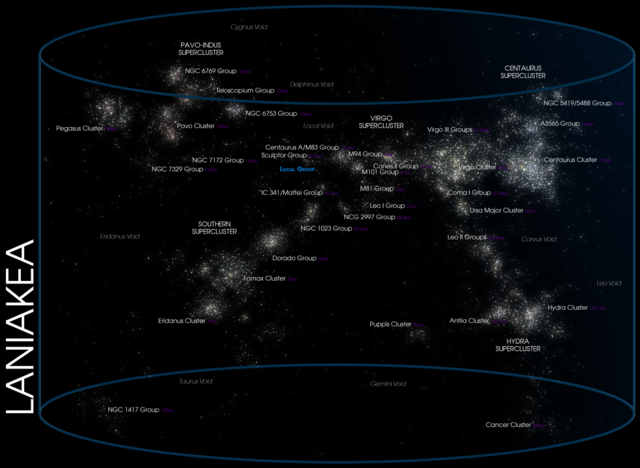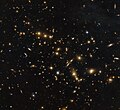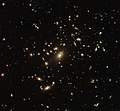Galaxy cluster
Structure made up of a gravitationally-bound aggregation of hundreds of galaxies From Wikipedia, the free encyclopedia
A galaxy cluster, or a cluster of galaxies, is a structure that consists of anywhere from hundreds to thousands of galaxies that are bound together by gravity,[1] with typical masses ranging from 1014 to 1015 solar masses. Clusters consist of galaxies, heated gas, and dark matter.[2] They are the second-largest known gravitationally bound structures in the universe after superclusters. They were believed to be the largest known structures in the universe until the 1980s, when superclusters were discovered.[3] Small aggregates of galaxies are referred to as galaxy groups rather than clusters of galaxies. Together, galaxy groups and clusters form superclusters.

Basic properties

Galaxy clusters typically have the following properties:
- They contain 100 to 1,000 galaxies, hot X-ray emitting gas and large amounts of dark matter.[2] Details are described in the "Composition" section.
- They have total masses of 1014 to 1015 solar masses.
- They typically have diameters from 1 to 5 Mpc (see 1023 m for distance comparisons).
- The spread of velocities for the individual galaxies is about 800–1000 km/s.
Composition
Galaxy clusters have three main components. Galaxies themselves only make up a small fraction of clusters, although they are the only component we can detect in the visible spectrum. The heated gas of the intracluster medium (ICM) has a peak temperature between 30 and 100 million degrees Celsius.[2] Dark matter makes up the majority of the mass of galaxy clusters, but cannot be detected optically.[3]
| Component | Mass fraction | Description |
|---|---|---|
| Galaxies | 1% | In optical observations, only galaxies are visible |
| Intergalactic gas in intracluster medium | 9% | Plasma between the galaxies at high temperature and emit x-ray radiation by thermal bremsstrahlung |
| Dark matter | 90% | Most massive component but cannot be detected optically and is inferred through gravitational interactions |
Cluster formation and evolution
As galaxy clusters form, massive amounts of energy are released due to shock waves, the heating of gas, and galaxy interactions.[3] Gas collides with existing material which generates shock waves, heating it to tens of millions of degrees and producing X-ray emissions. Galaxy evolution within the cluster is governed by interactions between galaxies, such as galaxy mergers, and gas stripping.
Classification
There are many classification systems for galaxy clusters, based on characteristics such as shape symmetry, X-ray luminosity, and dominant galaxy type.[5] The Bautz-Morgan classification sorts clusters into types I, II, and III based on the relative brightness of their galaxies–type I with greatest contrast and type III with the least.[6][7]
Galaxy clusters as measuring instruments
Summarize
Perspective
Gravitational redshift
Galaxy clusters have been used by Radek Wojtak from the Niels Bohr Institute at the University of Copenhagen to test predictions of general relativity: energy loss from light escaping a gravitational field. Photons emitted from the center of a galaxy cluster should lose more energy than photons coming from the edge of the cluster because gravity is stronger in the center. Light emitted from the center of a cluster has a longer wavelength than light coming from the edge. This effect is known as gravitational redshift. Using the data collected from 8000 galaxy clusters, Wojtak was able to study the properties of gravitational redshift for the distribution of galaxies in clusters. He found that the light from the clusters was redshifted in proportion to the distance from the center of the cluster as predicted by general relativity. The result also strongly supports the Lambda-Cold Dark Matter model of the Universe, according to which most of the cosmos is made up of Dark Matter that does not interact with matter.[8]
Gravitational lensing
Galaxy clusters are also used for their strong gravitational potential as gravitational lenses to boost the reach of telescopes.[9] The gravitational distortion of space-time occurs near massive galaxy clusters and bends the path of photons to create a cosmic magnifying glass. This can be done with photons of any wavelength from the optical to the X-ray band. The latter is more difficult, because galaxy clusters emit a lot of X-rays.[10] However, X-ray emission may still be detected when combining X-ray data to optical data. One particular case is the use of the Phoenix galaxy cluster to observe a dwarf galaxy in its early high energy stages of star formation.[11]
Notable galaxy clusters
Summarize
Perspective

Notable galaxy clusters in the relatively nearby universe include the Virgo Cluster, Fornax Cluster, Hercules Cluster, and the Coma Cluster. A very large aggregation of galaxies known as the Great Attractor, dominated by the Norma Cluster, is massive enough to affect the local expansion of the Universe. Notable galaxy clusters in the distant, high-redshift universe include SPT-CL J0546-5345 and SPT-CL J2106-5844, the most massive galaxy clusters found in the early Universe. In the last few decades, they are also found to be relevant sites of particle acceleration, a feature that has been discovered by observing non-thermal diffuse radio emissions, such as radio halos and radio relics. Using the Chandra X-ray Observatory, structures such as cold fronts and shock waves have also been found in many galaxy clusters.
| Cluster | Notes | |||||||||||||||||||||||||||||||||||||||||||||||||||||||||||||||||||||||||||||||||||||||||||||||||
|---|---|---|---|---|---|---|---|---|---|---|---|---|---|---|---|---|---|---|---|---|---|---|---|---|---|---|---|---|---|---|---|---|---|---|---|---|---|---|---|---|---|---|---|---|---|---|---|---|---|---|---|---|---|---|---|---|---|---|---|---|---|---|---|---|---|---|---|---|---|---|---|---|---|---|---|---|---|---|---|---|---|---|---|---|---|---|---|---|---|---|---|---|---|---|---|---|---|---|
| Virgo Cluster | The nearest massive galaxy cluster | |||||||||||||||||||||||||||||||||||||||||||||||||||||||||||||||||||||||||||||||||||||||||||||||||
| Norma Cluster | The cluster at the heart of the Great Attractor | |||||||||||||||||||||||||||||||||||||||||||||||||||||||||||||||||||||||||||||||||||||||||||||||||
| Bullet Cluster | A cluster merger with the first observed separation between dark matter and normal matter | |||||||||||||||||||||||||||||||||||||||||||||||||||||||||||||||||||||||||||||||||||||||||||||||||
| This lists some of the most notable clusters; for more clusters, see the list article. | ||||||||||||||||||||||||||||||||||||||||||||||||||||||||||||||||||||||||||||||||||||||||||||||||||
Gallery
Left: Image by the Hubble Space Telescope (2017) Right: Image by the James Webb Space Telescope (2022)[12]
Images
- Galaxy cluster SPT-CL J0615-5746.[21]
- Galaxy cluster RXC J0232.2-4420.[22]
- Massive galaxy cluster PSZ2 G138.61-10.84 is about six billion light-years away.[24]
- Abell 2537 is useful in probing cosmic phenomena like dark matter and dark energy.[26]
- Abell 1300 acts like a lens, bending the very fabric of space around it.[27]
- Galaxy cluster WHL J24.3324-8.477.[28]
- Background galaxy has been gravitationally lensed by the intervening galaxy cluster.[29]
- "Smiley" image – galaxy cluster (SDSS J1038+4849) & gravitational lensing (an Einstein ring) (HST).[30]
- Galaxy cluster SpARCS1049 taken by Spitzer and the Hubble Space Telescope.[31]
- Galaxy cluster MOO J1142+1527 discovered by the MaDCoWS survey
- Magnifying the distant universe through MACS J0454.1-0300.[32]
- Turbulence may prevent galaxy clusters from cooling; illustrated: Perseus Cluster and Virgo Cluster (Chandra X-ray).
- MACS0416.1-2403 imaged by the HST
- The galaxy cluster Abell 2813 (also known as ACO 2813) image from the NASA/ESA Hubble Space Telescope
- A menagerie of galaxies — the galaxy cluster ACO S 295
- Cosmic lens flare
- Hubble spots three images of a distant supernova
- A massive galaxy cluster called WHL0137-08
- Galaxy cluster known as "El Gordo"
- Observation from the James Webb Space Telescope the massive galaxy cluster RX J2129.[33]
Videos
- Video: Formation of galaxy cluster MRC 1138-262 (artist's concept).
See also
Wikimedia Commons has media related to Galaxy clusters.
References
Wikiwand - on
Seamless Wikipedia browsing. On steroids.


























